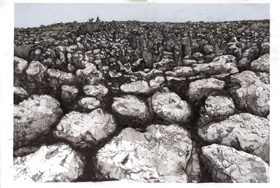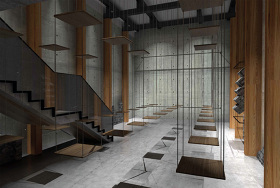Dion Andrews
MArch (Prof) Thesis Supervisor: Daniel K. Brown
School of Architecture, Victoria University of Wellington
Andrews, Dion. THE GRAVEYARD OF UNWRITTEN BOOKS. Master of Architecture (Professional) 2020.
Click here to read the compete thesis.
Over recent decades, we have arrived in an age where mass production, prefabrication and economic stresses make it increasingly economical to formulate architectural fixtures and fittings that are generic to a multiplicity of programmatic and spatial requirements. Unfortunately, this development has diminished the capacity of fixtures and fittings to actively contribute to an evolving and enriching human experience within architecture. In literary fiction, however, the nuanced detail is fundamental to our individual experience of key ideas presented within the wider text. This design-led research investigation considers how key ideas drawn from literary fiction can be applied to architecture. It argues that when fixtures and fittings are designed to explicitly contribute to a tailored experiential narrative, our architectural experience can be greatly enhanced.
This design-led research investigation integrates narrative theory with curation theory. The investigation uses Nedim Gürsel’s short story “The Graveyard of Unwritten Books” as a literary provocateur—an allegorical generator for investigating how the architectural detail, in the form of fixtures and fittings, can play a fundamental role in conveying important underlying ideas about an architectural space. The research interrogates the arguments of architectural theorist Marco Frascari in his seminal article, “The Tell-The-Tale-Detail”, in which he distinguishes the architectural detail not only as a pragmatic joint or condition, but also as a generator in the process of signification—the attachment of meaning to an object. The research also interrogates the writings of museum curation theorist Laura Hanks, who provides a succinct framework within which curating objects, as a design method to enhance meaning and experiential participation, can be implemented and its capacity for narrative transformation assessed.
Speculative in nature, this thesis investigation positions the focus of design and interrogation on the uniquely designed architectural artefact. It privileges drawing, crafting, and other analogue design methods in order to explore the storytelling potential of uniquely designed custom architectural fixtures and fittings, as generators of meaningful architectural experiences. Iterative and experimental, this speculative design-led research investigation engages methods of drawing and making, in conjunction with theories of synecdoche and museum curation, in order to ask:
How can crafted, custom-designed architectural fixtures and fittings be designed explicitly to help convey important metaphorical and experiential ideas about a building’s program, occupants, and spatial identity?





























































































